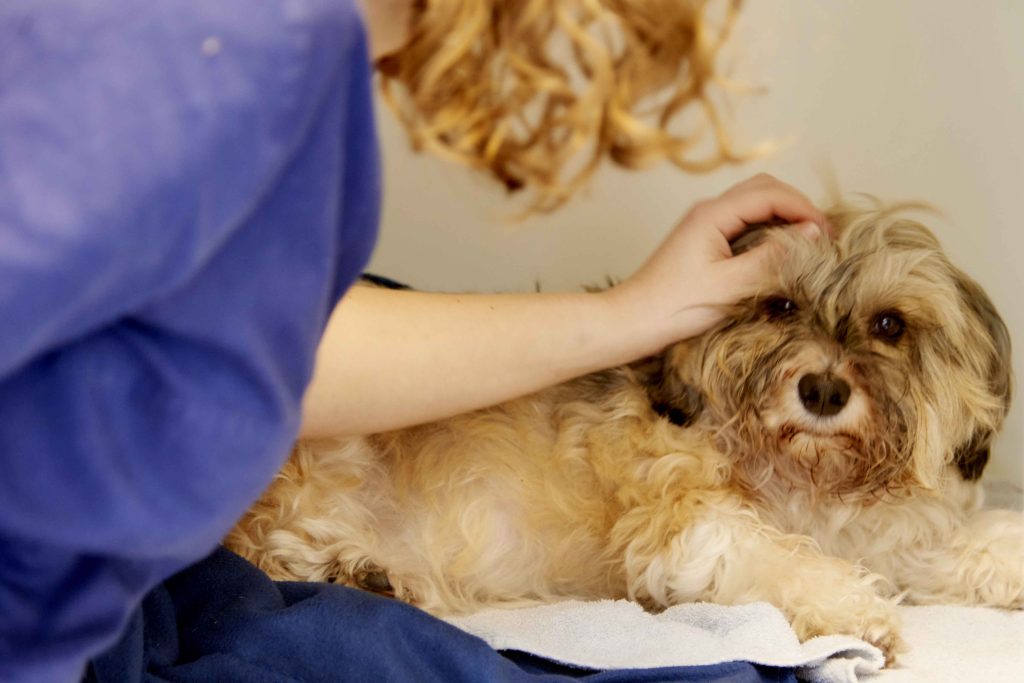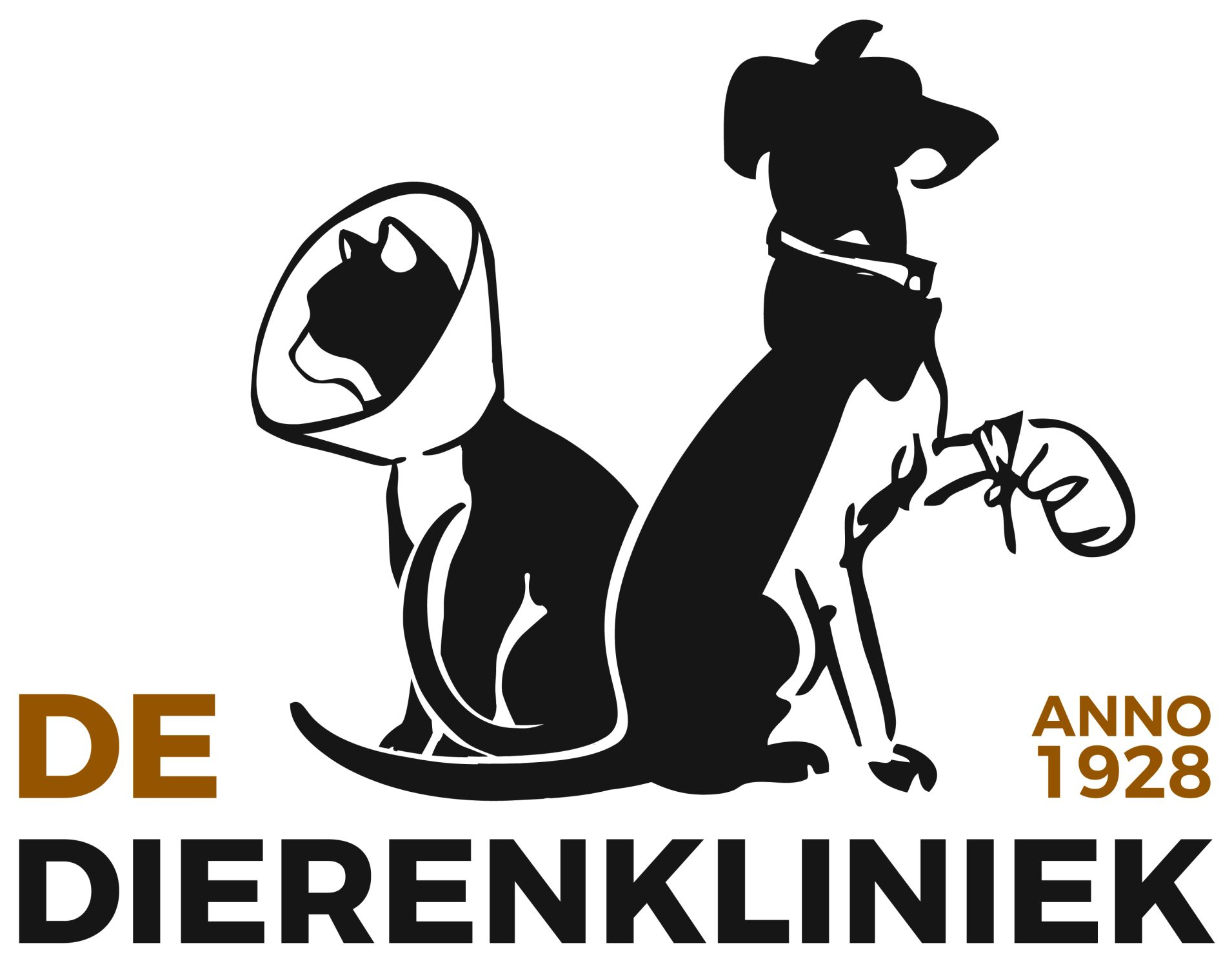Spaying your female dog
In the case of females, we usually talk about spaying or sterilisation. Actually, this is incorrect, because we technically castrate them. What exactly is the difference? During spaying, you tie off the ovaries, while during castration, you remove them completely. In veterinary medicine, we always remove the ovaries, as this stops the production of hormones.
However, veterinarians use the term spaying or sterilisation to avoid confusion with male dogs.
What is the best age to spay your dog?
In general, we advise your dog to be spayed 3 months after her first heat. We can deviate from this advice in consultation, but it is important to know that we never perform the spay during heat. The blood flow to the ovaries and uterus is very high during this period, which increases the risk of complications.
Most dogs go into heat twice a year. There are some exceptions however: certain large breeds, such as the Basenji and wolfhounds, go into heat only once a year. The period of heat lasts three weeks on average.
In large dog breeds, females have their first heat when they are between 10 and 16 months old. In small breeds, it is often earlier, between 6 and 10 months of age.
What are the benefits of spaying?
Infertility
By removing the ovaries, you make the female dog “sterile”; she is infertile and can no longer have puppies. Your dog will also no longer go into heat.
Positive effect on behaviour around heat
Spaying has no effect on the dog’s friendliness, playfulness or personality. However, spaying does have a positive effect on the dog’s behaviour around her heat. You will see less or no typical behaviour anymore.
Less risk of tumors
By spaying a female dog, you reduce the risk of (malignant) mammary tumors (tumors of the mammary glands). When the dog is spayed just before or after the first heat, the risk of this is almost zero. The later in life you spay your dog, the less reduction of the chance of mammary tumors there is. Scientific studies have shown that we should spay at least before the age of 2,5 years to reduce the risk of developing malignant mammary tumors. When a dog is spayed at a later age, only the chance of developing benign mammary tumors decreases.
No uterine infection
Due to hormonal influences, a female dog can develop a uterine infection, also called pyometra. This is a very serious disease. After removing the ovaries, there is no more hormonal influence. Therefore, there is no longer a risk of developing a uterine infection.
No false pregnancy
If a dog is not spayed, it is possible that she becomes false pregnant after her heat. In principle, this is a beautiful, natural process. After all, in nature only the highest ranking female gets a litter. The other females in the pack must also be able to take care of her pups (give milk), for example when the mother dog is hunting. This is why they become false pregnant.
This function is no longer necessary for our “domestic dogs.” As a result, false pregnancy can causes annoying complications, such as behavioural changes, milk production and possible mammary gland inflammation.
Reduced risk of diabetes
The hormone progesterone is formed in the ovaries. This hormone causes increased sugar production in the body. This can cause diabetes. In addition, it can also disrupt diabetes. Dogs with diabetes should also be spayed for this reason. By removing the ovaries, the production of progesterone is stopped, reducing the risk of diabetes.
What are the disadvantages of a spay?
Weight gain
After being spayed, the energy balance of a female dog may change, which can lead to more rapid weight gain. It is important to monitor your dog’s weight after the spaying procedure and adjust the amount or type of food if necessary. If you need advice on nutrition and/or your dog’s weight, please contact us. We can provide you with customised nutritional advice.
Incontinence
Spayed females are more likely to develop incontinence as they age than females that have not been spayed. Fortunately, these problems can be effectively treated with medication. The risk of incontinence is somewhat higher in certain breeds, such as Boxers, Newfoundlands, Dobermans, Weimaraners, Ridgebacks and Bouviers.

Change of coat
It sometimes happens that the coat of (semi-)long-haired dogs changes after spaying. The change you may observeis that the coat becomes curlier and/or duller. This does not affect the health of the dog in any way.
Choice between traditional and laparoscopic spay surgery
At all of our clinics, you can choose to have your female dog sterilized using either the traditional method or laparoscopic (keyhole) surgery.
Traditional spay
During the traditional sterilization, we make a minimal incision in the abdominal wall. This way, we can access both ovaries, which we remove. The ovaries are located at the back of the abdominal cavity in a female dog. The larger the dog, the deeper the veterinarian must reach into the abdominal cavity to access the ovaries.
Laparoscopic spay
During a laparoscopic sterilisation, 1, 2, or 3 small incisions of 0,5 – 1cm are made in the abdominal wall. Through these openings, the vet uses a camera and instruments to enter the abdominal cavity. The camera’s image is magnified on a screen, allowing the surgeon to see where they need to be. Both ovaries are removed and retrieved through the same incisions.
We recommend laparoscopic surgery for dogs of approximately 10kg body weight and above
Research show that larger dogs spayed via the traditional method move 62% less than normal the day after surgery, versus dogs spayed laparoscopically 25% less. It is therefore likely that this method is less painful. For smaller dogs, the vet does not have to go as deep into the abdominal cavity to reach the ovaries, and a smaller incision in the abdominal wall is required anyway than for larger dogs. This technique is therefore particularly suitable for dogs weighing 10 kg or more. This method has no added value for cats.
How does spaying work?
All our clinics have a very extensive operating room provided with state-of-the-art equipment. In addition, our veterinarians have ample surgical experience.
Preparation
It is important that your dog is fasted before surgery. This means that she should not eat for 12 hours before the procedure. This is because animals can vomit from the anesthesia, and if they have eaten, food can get stuck in their throat. Your dog is allowed to drink water though.
Please walk your dog before bringing her to the clinic. During anesthesia, she may run her feces and urine and this gets into her fur. This causes less hygiene during surgery. It is also more pleasant for your dog to wake up with a clean coat.
The procedure
Before your dog goes under anesthesia, we examine her completely to be sure your dog is healthy. Next, we place an IV into a blood vessel in one of the front paws. Through this drip, we give anesthetics that will put your dog to sleep quickly and safely. Then we place a tube in the trachea through which we can give oxygen and gas anesthesia and connect her to the monitoring equipment. During the procedure, this monitoring equipment is used to monitor heart rate, ECG and breathing. We also give additional IV fluids to maintain blood pressure.
During surgery, both ovaries are removed. The uterus does not need to be removed. However, we always inspect it for abnormalities. After the ovaries are removed, the abdominal wall and the wound are sutured with subcutaneous stitches.
Recovery and aftercare
Your dog can go home on the day of the surgery. Our nurse will call you as soon as we know what time you can come and pick up your dog. You will receive an aftercare letter that explains exactly what you can do for your dog after the procedure. Please consider how you will bring your dog home when picking him up. Your dog has been under anesthesia and may still be groggy and more susceptible to getting cold. It is not recommended to take a long walk.
Drinking
You may offer your dog small amounts of water after surgery. Do not give him too much at once. If your dog drinks too much water in short period of time, it may cause him to vomit.
Eating
Several hours after surgery, you may offer your pet some food. Start with about ¼ of the normal amount because your pet may still be a little nauseous from anesthesia. We will provide you with a can of easily digestible food for the first evening.
Medication
Your dog will receive pain medication before surgery. Sometimes we see that dogs (especially Retrievers) may be a bit agitated or restless due to one of the pain relievers they have received. This will go away on its own.
We will provide you with painkillers for the first few days after surgery. You can start giving these the day after surgery. Even if you feel that your dog is not in pain (anymore), it is important to give these because they also have an anti-inflammatory effect. Antibiotics are not necessary.
The wound
The sutures are both in the skin as well as in deeper layers of the tissue. If your dog jumps or makes a sudden movement shortly after surgery, these sutures may tear. Therefore, it is important to keep your dog as calm as possible. He should not touch or lick the wound. If he does, he must wear a collar or a medical pet shirt. Dogs should be walked on a leash until the wound has been checked by us, and is not be allowed to swim until then.
Wound check
We would like to see your dog back at the clinic after 7-10 days for a wound check. There is no charge for this. If the wound looks good, your dog can do everything as usual. Of course, in the meantime you may always contact us if you have any questions.
What is the cost of spaying your dog?
You can find an estimate of the costs for spaying your dog on our contact page. You can also call, whatsapp or email our clinics for a price estimate.
Contact
If you are thinking about having your dog spayed, feel free to stop by for advice or contact us. Our nurses can also help you with questions about behaviour.

